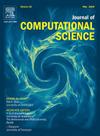An efficient quantum circuit for block encoding a pairing Hamiltonian
IF 3.1
3区 计算机科学
Q2 COMPUTER SCIENCE, INTERDISCIPLINARY APPLICATIONS
引用次数: 0
Abstract
We present an efficient quantum circuit for block encoding a pairing Hamiltonian often studied in nuclear physics. Our block encoding scheme does not require mapping the creation and annihilation operators to the Pauli operators and representing the Hamiltonian as a linear combination of unitaries. Instead, we show how to encode the Hamiltonian directly using controlled swap operations. We analyze the gate complexity of the block encoding circuit and show that it scales polynomially with respect to the number of qubits required to represent a quantum state associated with the pairing Hamiltonian. We also show how the block encoding circuit can be combined with the quantum singular value transformation to construct an efficient quantum circuit for approximating the density of states of a pairing Hamiltonian. The techniques presented can be extended to encode more general second-quantized Hamiltonians.
求助全文
约1分钟内获得全文
求助全文
来源期刊

Journal of Computational Science
COMPUTER SCIENCE, INTERDISCIPLINARY APPLICATIONS-COMPUTER SCIENCE, THEORY & METHODS
CiteScore
5.50
自引率
3.00%
发文量
227
审稿时长
41 days
期刊介绍:
Computational Science is a rapidly growing multi- and interdisciplinary field that uses advanced computing and data analysis to understand and solve complex problems. It has reached a level of predictive capability that now firmly complements the traditional pillars of experimentation and theory.
The recent advances in experimental techniques such as detectors, on-line sensor networks and high-resolution imaging techniques, have opened up new windows into physical and biological processes at many levels of detail. The resulting data explosion allows for detailed data driven modeling and simulation.
This new discipline in science combines computational thinking, modern computational methods, devices and collateral technologies to address problems far beyond the scope of traditional numerical methods.
Computational science typically unifies three distinct elements:
• Modeling, Algorithms and Simulations (e.g. numerical and non-numerical, discrete and continuous);
• Software developed to solve science (e.g., biological, physical, and social), engineering, medicine, and humanities problems;
• Computer and information science that develops and optimizes the advanced system hardware, software, networking, and data management components (e.g. problem solving environments).
 求助内容:
求助内容: 应助结果提醒方式:
应助结果提醒方式:


